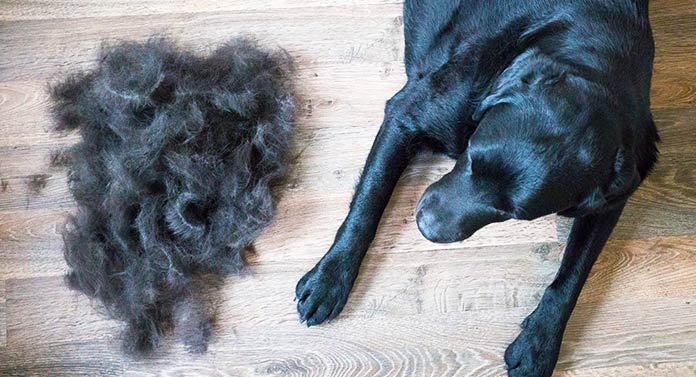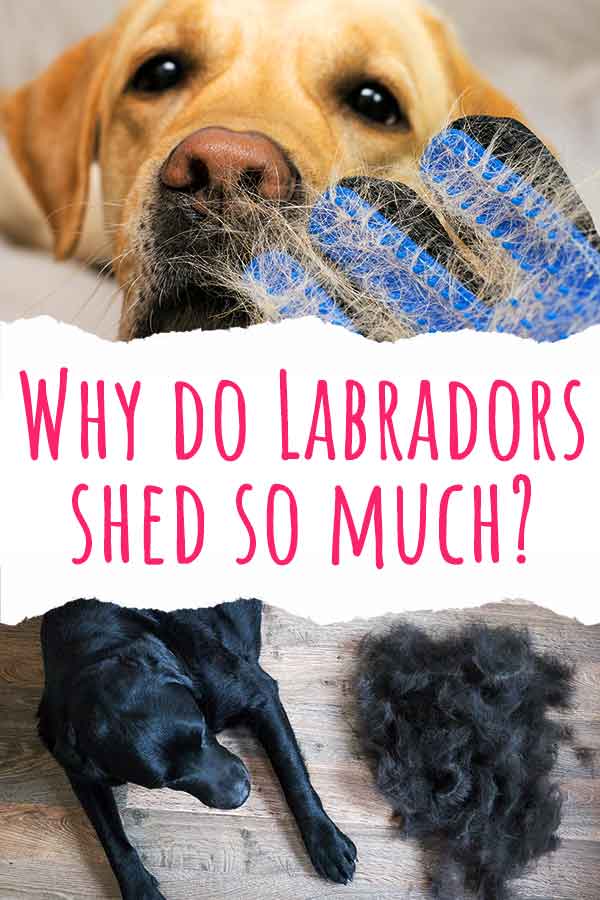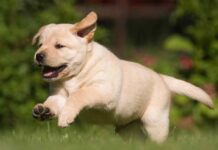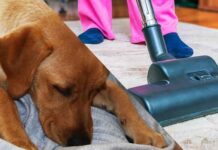Lots of Lab owners tend to wonder, as they survey the drifts of shed hair that settle over their home every day, “why DO Labradors shed so much?” Labradors have dense double coats which protect them from harsh weather whilst working outside. Their coats shed so that old, broken and damaged hairs can be replaced. They shed a lot because they have a lot of hair! But things like season, environment, lifestyle, and health problems can also affect how much a Labrador sheds.
Why Do Labradors Shed So Much?
There are countless things to love about Labrador Retrievers. They’ve been America’s favorite dog breed for decades, because they’re just brilliant all round workers and companions.
There’s little that lets them down, but most Lab owners would agree that the amount of hair they shed is a bit of a drawback. Labradors shed so abundantly that it sometimes seems a wonder they have any fur left on their bodies! In this article we’ll explain why Labs shed so much, when excessive shedding is a sign of an underlying health problem, and how to manage your Lab’s coat to keep on top of shedding.
Your Labrador’s Coat
Much as their name suggests, Labradors are descended from working dogs from the Labrador and Newfoundland region of Canada. Their ancestors had thick, oily, double coats, which mean they could work comfortably in freezing temperatures, and swim in icy water. This was vital for them to fulfil their purpose as working dogs – spending long, hard days out in the elements.
Modern Labradors still have a warm, soft under coat, and a coarse, protective outer coat. But the way they live now means that their coats behave quite differently in terms of shedding. And to understand why that is, we need to look first at the function of shedding, and why dogs have to do it in the first place.
The Science Of Shedding
All hair sheds – even the so-called non-shedding breeds shed a little. And it’s all down to the hair cycle. The first stage of the hair cycle is the anagen phase. Hairs in the anagen phase are actively growing longer. Following the anagen phase is a brief transitional phase called the catagen phase, leading to the telogen phase. Hairs in the telogen phase have stopped growing, and just exist, until they fall out and a new hair in the anagen phase replaces them.
In the past it was thought that the new hair pushes the old one out. But more recently researchers have proposed that chemical changes in the follicle of the old hair actually cause it to fall out.
What does this tell us?
It tells us that how much dogs shed depends upon how quickly their hairs progress through the hair cycle. The hairs of non-shedding breeds (such as Poodles) spend years and years in the anagen phase, for example. Which means they fall out very infrequently. But dogs with a quick anagen phase and a short telogen phase shed hairs and replace them in rapid succession. Like our beloved Labrador. But what is the benefit of it to them?
Why Do Dogs Have To Shed At All?
For dogs, continually replacing their coat demands energy. So it must have some kind of survival advantage in order to be worthwhile. Labradors’ coats keep them warm, waterproof, and protect their skin by deflecting things that could damage it. But the hairs themselves are prone to breakages and overall deterioration in quality. So replacing them keeps the coat in tip-top condition, and fit for purpose.
Shedding hairs faster or slower at different times of year also enables dogs to adapt to the changing of the seasons and maintain a comfortable temperature all year round. Let’s look more closely at that next.
Why Do Labradors Shed So Much In Spring And Fall?
Traditionally, working Labradors who spent most of their lives outside would “blow their coat” twice a year. Once at the beginning of spring, and again at the onset of fall. During this time, they would shed large quantities of fur, and the coat which replaced it would be better suited to the new season. A thicker undercoat for winter, and a sparser one for summer.
In between, they would shed relatively little. But that has changed for lots of our pet Labs today.
Why Do Labradors Shed So Much Indoors?
Modern pet Labradors spend much more time indoors than their working forebears. They’re more likely to sleep inside the home with us than be kennelled outdoors, and they might only go outdoors during the day for exercise. So they are much less affected by the changing of the seasons.
Most Labrador parents report that their dogs still blow their coat to some degree twice a year. But their constant living conditions means that they tend to shed their fur at a constant rate all year round too. It’s simply their coat adapting to life in a steady environment, by behaving in a steady way.
Is It Shedding That Triggers Allergies?
So now we know why Labradors shed so much. Next let’s look at what shedding means for us, and what too much shedding means for them. Contrary to popular belief, Labradors don’t cause allergies because they shed so much. In fact, humans aren’t allergic to dog hairs themselves at all. Dog allergies are actually triggered by proteins in dogs’ saliva, sweat and urine.
So no dog breed is truly hypoallergenic. But shed hair can help to spread those allergenic proteins around our homes, when dogs groom and kick their coat before the hairs are shed. Which may be why some people find that living with non-shedding breeds has less impact on their allergies.
Reasons For Excessive Shedding
It’s normal for Labradors to shed a lot, and shed continuously all year round. And even to shed still more for a few weeks in spring and fall. But excessive shedding can also be a symptom of some health conditions. This differs from normal shedding because it happens out of season, happens continuously for a long period, or happens so much that your Lab starts to develop bald patches. Reasons can include:
Stress
Physical or emotional stress can trigger a period of ‘telogen effluvium’ in dogs. Which means lots of the coat which would normally be in the anagen (growth) phase gets bumped to the telogen phase, to conserve energy. This means that a larger than usual amount of coat will reach the end of the telogen phase at the same time, and be shed at once.
Since this kind of hair loss has a built in delay (it doesn’t happen until the affected hair reached the normal end of the telogen phase for that dog) it usually doesn’t occur until weeks or months after the stressful event which triggered it. Stressed out dogs might also cause more immediate excessive hair loss to themselves, if they use compulsive self-grooming as a coping mechanism.
Allergies
Hair loss and bald patches are a common symptom of allergies in dogs. Dogs can be allergic to ingredients in their food, things they touch in their environment (such as detergent on their bedding) and things they inhale (such as pollen). We’ve written about common allergies in Labradors here.
Nutritional deficiencies
Dogs need a complete and balanced diet to maintain a healthy coat. For example, inadequate copper and zinc are both linked to hair loss. Most commercially available dog foods are formulated to include all the nutrients and minerals dogs need for healthy coat growth. Your vet can advise you if your Lab’s diet might be the cause of their hair loss, and how to remedy it.
Disease
Labradors are vulnerable to several diseases which include hair loss as a symptom, including:
- dermatitis caused by allergies
- dermatitis caused by excessive licking
- follicular dysplasia (structural deformities of the hair follicles which stops hair growing properly)
- seasonal flank alopecia (in which patches of hair are lost from the sides of the abdomen every winter)
- and sebaceous adenitis.
Your Lab’s vet is best placed to make a diagnosis of any of these conditions and recommend treatment.
Hormone changes
There are several reasons why changes in hormones can cause hair loss. Some of them are benign and eventually resolve themselves, like pregnancy. Whilst others need managing by a vet, like hypothyroidism.
Managing Your Labradors’ Shedding
Assuming your Labrador is healthy, and the amount they shed, whilst hard to believe, is completely normal, let’s move on to dealing with it. Shed fur is an unavoidable part of life with a Lab. But, keeping on top of it can make a huge difference to the impact it has on your home.
Brushing your Lab’s coat regularly to dislodge hair near the end of its life cycle will help limit shedding to the time and place that you brush them. Pippa has written about the grooming tools she uses for managing seasonal shedding in particular over here.
It’s also much easier to collect up shed fur from furniture and carpets if you do it promptly, rather than letting it get worked in. Which means forming a regular vacuuming habit, and sticking to it religiously! Pippa has reviewed her favorite vacuums for the job in this article.
Why Do Labradors Shed So Much? Summary
Labradors shed so much because they have a lot of fur in the first place, which they shed and replace to keep their coat in good condition and at the right thickness for the temperature of their environment. Some medical conditions can make shedding worse. But since most shedding is normal (yes, all of it!) the best way to manage it is by regular grooming and vacuuming.
Would you like to swap tips for coping with shedding with other Lab owners?
Why not join us in the forum?
References
Brooks. Seasonal Flank Alopecia in Dogs. Veterinary Partner. 2019.
Cavanagh & Bell. Veterinary Medical Guide To Cat And Dog Breeds. CRC Press. 2012.
Downing. Nutrition, Skin, and Dogs. VCA Animal Hospitals. Accessed November 2020.
Nagata. Clinical Approach to Alopecia in Dogs. World Small Animal Veterinary Association World Congress Proceedings. 2011.
Rooney et al. A practitioner’s guide to working dog welfare. Journal of Veterinary Behavior. 2009.
Shipstone. Alopecia in the dog. World Small Animal Veterinary Association World Congress Proceedings. 2013.
Vredegoor et al. Can f 1 levels in hair and homes of different dog breeds: Lack of evidence to describe any dog breed as hypoallergenic. Journal of Allergy and Clinical Immunology. 2012.
The Labrador Site Founder
Pippa Mattinson is the best selling author of The Happy Puppy Handbook, the Labrador Handbook, Choosing The Perfect Puppy, and Total Recall.
She is also the founder of the Gundog Trust and the Dogsnet Online Training Program
Pippa's online training courses were launched in 2019 and you can find the latest course dates on the Dogsnet website




















I always love your information. Good content as always